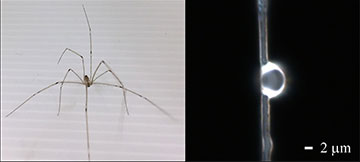
An image of the spider used in the study and the dome lens generated on its dragline silk. [Image: Cheng-Yang Liu]
As anyone who’s unsuspectingly walked through a spider web can attest, the sticky strands can be a nuisance. Yet it turns out that the silky fibers are surprisingly useful for biomedical applications, thanks to the material’s impressive tensile strength, biocompatibility and high elasticity.
Now, researchers at two universities in Taiwan have capitalized on these properties to engineer biocompatible lenses for biological imaging (J. Appl. Phys., doi: 10.1063/5.0007611). According to coauthor Cheng-Yang Liu at National Yang-Ming University in Taipei City, these dome lenses could someday be used as the optical hybrid devices in photonic chips for high-quality sensing and imaging.
Unravelling spider silk
In addition to excellent mechanical properties, spider silks are biocompatible and bioresorbable, making the natural material useful for applications such as tissue engineering. Furthermore, the multifunctional fibers have piqued the interest of photonic researchers, says Liu, for applications involving light guiding, imaging and sensing.
Spiders can spin several different kinds of silk, but for the purposes of their study, the researchers at Tamkang University and National Yang-Ming University focused on “dragline silk”—which spiders weave to frame their webs. “Dragline silk is an interesting natural material because of its significant features such as high elasticity, great toughness, and large tensile strength,” says Liu. “It also exhibits the directional liquid collection phenomenon, so silk shape can be changed by its structural wet-rebuilding.”
These properties taken together inspired the researchers to pursue spider silk as a platform for a natural optical biolens. According to Liu, by customizing the dimensions of such a lens and illuminating it to create a flexible photonic nanojet (PNJ)—a near-field non-resonant focusing point with high intensity and a subwavelength waist—one could overcome the diffraction limit in far-field optical systems. In principle, he says, this could make a spider-silk-based lens “suitable for imaging nanoscale objectives in different depths within biological tissue.”
Photonic nanojet beam shaping
To create their lens, the researchers extracted a 7-cm-long reel of dragline silk from the colloquially named “daddy long-legs” spider (Pholcus phalangioides), stretching and clamping it to keep the fiber taught. After placing wax under the bare silk fiber, they dripped a photocurable resin onto the strand until the natural wetting properties of the material formed a dome as the resin condensed on the silk. The lens solidified after curing for 12 seconds in an ultraviolet oven, resulting in a solid, dielectric dome lens with customizable dimensions.
In experiments, the team shone a laser—at 405 nm, 532 nm and 671 nm—onto the lens, creating a high-quality PNJ, and then evaluated beam shaping property and detected the intensity distributions generated from the dome lens. To customize the lens for a specific function, the researchers controlled the amount of time that the silk spent under the resin drip, thereby tuning the size of the lens and optimizing the generated PNJ. In their paper, they also report direct imaging of the PNJs and using numerical modeling to systematically study the key parameters of the PNJs depending on lens size.
According to the researchers’ findings, PNJs formed by lenses with different radii have different locations, focal lengths, full widths at half-maximum (FWHMs) and maximal peak amplitudes. This shows, they write, that there is indeed a dimensional effect of the dome lens on the PNJ beam shaping, and modifying the shape of the lens will change the power flow pattern.
As for next steps, Liu and colleagues are interested in pursuing animal experimentation to eventually realize biological imaging and therapy with their lenses.
